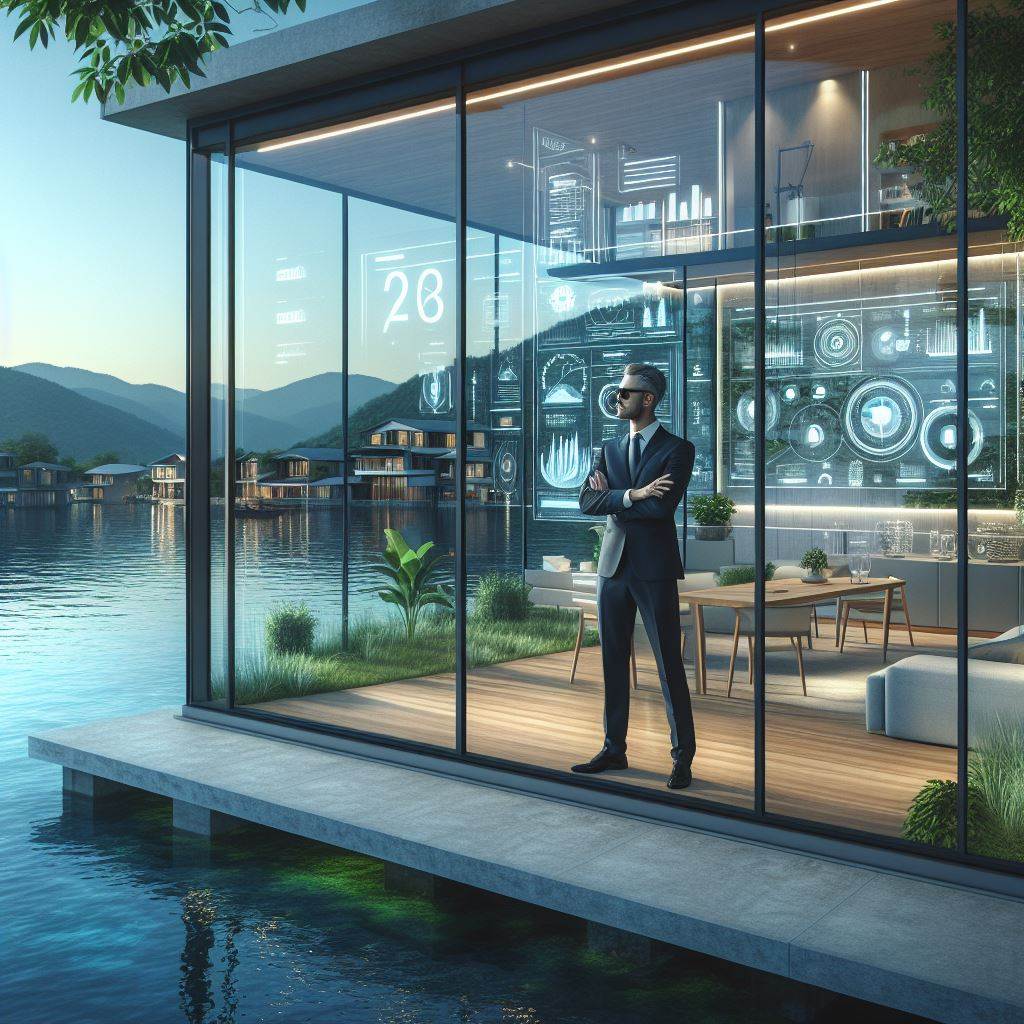Introduction
The allure of waterfront real estate has always been undeniable, captivating dreamers and investors alike.
As we step into 2024, the significance of waterfront properties has reached new heights.
This post explores the importance of waterfront real estate, provides an overview of current trends in the real estate market, and zeroes in on the key developments to watch in 2024.
Waterfront properties have a timeless appeal, offering a unique blend of natural beauty and exclusivity.
The calming presence of water, whether it’s an ocean, lake, or river, adds an intrinsic value to these estates.
The demand for waterfront real estate continues to surge as individuals seek homes that provide not just shelter but an immersive experience in nature.
Beyond the aesthetic appeal, waterfront homes often boast higher resale values, making them lucrative investments.
The real estate market is a dynamic ecosystem, constantly evolving to meet the changing needs and desires of buyers.
In recent years, we’ve witnessed trends like sustainable living, smart home technology, and communal spaces influencing real estate choices.
However, the waterfront real estate sector stands out as a unique niche, driven by factors such as climate awareness, desire for privacy, and the growing popularity of remote work.
As we delve into 2024, several trends are set to reshape the waterfront real estate landscape.
Climate-resilient designs take center stage as buyers become increasingly mindful of the potential impact of rising sea levels and extreme weather events.
Sustainable features, from solar panels to eco-friendly landscaping, are becoming prerequisites for many waterfront properties.
Moreover, the integration of advanced technology for security and energy efficiency is transforming these homes into smart, efficient sanctuaries.
In fact, the year 2024 promises exciting developments in waterfront real estate.
Whether you are a prospective buyer, seller, or investor, staying attuned to these trends will be crucial for navigating the dynamic waters of this captivating market.
Growing Demand for Waterfront Properties
When it comes to real estate, waterfront properties are becoming increasingly sought after.
There are several factors contributing to this growing demand:
Appeal of waterfront living
- People have always been drawn to the water, finding it calming and soothing.
- The picturesque views of lakes, rivers, or oceans are highly desirable for homeowners.
- The serene ambiance and tranquility of waterfront living create a sense of exclusivity and luxury.
- Being close to the water provides an instant escape from the fast-paced city life.
- Waterfront properties offer unique opportunities for various water-based activities.
Escalating interest in nature and outdoor activities
- The rising focus on health and fitness has fueled the desire for outdoor living spaces.
- Waterfront properties allow residents to engage in water sports, boating, fishing, and swimming.
- Living near the water provides access to hiking, biking, and other outdoor recreational activities.
- Proximity to green spaces and natural environments promotes an active and healthy lifestyle.
- Being surrounded by nature reduces stress levels and enhances overall well-being.
Benefits of waterfront properties for relaxation and well-being
- The sound of water lapping against the shore has a calming effect on the mind and soul.
- Waterfront homes offer privacy and a sense of serenity, away from the hustle and bustle.
- Living by the water creates a connection with nature, fostering a sense of harmony.
- Waterfront properties often boast spacious outdoor areas, perfect for relaxation and entertaining.
- Unobstructed views of the water, sunsets, and wildlife contribute to a peaceful and idyllic atmosphere.
Overall, the demand for waterfront properties is expected to continue growing in the coming years.
As more people seek a balance between urban living and the desire for natural surroundings, waterfront real estate offers the perfect solution.
The allure of living by the water, coupled with the increasing interest in outdoor activities and the numerous benefits for relaxation and well-being, make waterfront properties highly desirable.
Whether it’s a serene lakefront retreat, a beachside oasis, or a riverfront haven, waterfront living provides a unique and fulfilling lifestyle for those fortunate enough to indulge in it.
Read: Smart Tips for First-Time Luxury Investors
Climate Change and Rising Sea Levels
Potential impact on waterfront real estate
- Rising sea levels can lead to increased flooding and erosion of coastal properties.
- Properties located close to the water may become more susceptible to damage from severe weather events.
- Higher insurance premiums and increased maintenance costs can reduce the affordability of waterfront properties.
- Loss of scenic views due to flooding or the construction of protective infrastructure can decrease property values.
- Decreased demand for waterfront real estate as the risks associated with climate change become more widely recognized.
Importance of considering climate risks in property investments
- Investors need to assess the potential risks and vulnerabilities of waterfront properties to climate change.
- Increased transparency and disclosure of climate-related risks help investors make informed decisions.
- Failure to consider climate risks can lead to financial losses and decreased property values in the future.
- Investors should work with experts to evaluate the resilience and adaptability of waterfront properties.
- Long-term investments in coastal areas should include climate change adaptation strategies.
Strategies for adapting to climate change in waterfront communities
- Implementing flood-resistant designs and construction techniques to mitigate damage from rising sea levels.
- Developing comprehensive stormwater management systems to prevent flooding and erosion.
- Creating protective infrastructure, such as seawalls and barriers, to minimize the impact of storms and high tides.
- Encouraging the use of sustainable and resilient materials in waterfront property construction and renovations.
- Designing waterfront communities that prioritize green spaces and natural buffers against climate change impacts.
All in all, climate change and rising sea levels pose significant challenges to waterfront real estate.
The potential impacts include increased flooding, higher insurance costs, and decreased property values.
It is crucial for property investors to consider climate risks and work with experts to adapt to the changing environment.
Strategies such as flood-resistant designs, stormwater management systems, and protective infrastructure can help waterfront communities withstand the effects of climate change.
By prioritizing sustainability and resilience, stakeholders can ensure the long-term viability of waterfront properties in the face of a changing climate.
Read: Oceanfront vs. Lakefront: Luxury Property Duel

Technological Advancements in Waterfront Properties
In the ever-evolving real estate industry, technological advancements play a pivotal role in shaping the future of waterfront properties.
With the growing demand for modern amenities and sustainable living, developers are embracing innovative solutions to enhance the quality of waterfront homes.
In this section, we will explore three prominent technological trends that will dominate the waterfront real estate market in 2024.
Integration of smart home technology
Smart home technology has revolutionized the way we live, and waterfront properties are no exception.
Homeowners now have the ability to control various aspects of their homes, such as lighting, temperature, security systems, and entertainment, through their smartphones or voice assistants.
This integration allows residents to create personalized environments tailored to their preferences, such as setting the perfect ambiance for a sunset dinner or ensuring energy efficiency when the property is unoccupied.
Moreover, smart home technology offers enhanced security features, including surveillance cameras and remote monitoring, giving homeowners peace of mind.
Energy efficiency measures for waterfront homes
As the world moves towards a greener future, energy efficiency has become a key consideration for homeowners and developers.
Waterfront properties, with their unique set of challenges, require innovative solutions to minimize energy consumption.
This trend includes the adoption of renewable energy sources, such as solar panels and wind turbines, to power homes.
Additionally, advanced insulation and energy-efficient appliances contribute to reducing electricity and water usage.
Developers are also incorporating smart energy management systems that optimize energy distribution based on real-time conditions.
These systems can regulate heating and cooling, adjust lighting levels, and track energy usage patterns, leading to significant cost savings and a reduced ecological footprint.
Insulation and construction improvements for extreme weather conditions
Waterfront properties are susceptible to extreme weather conditions, including hurricanes, storms, and rising sea levels.
To mitigate risks and ensure the safety of residents, technological advancements in insulation and construction techniques are paramount.
New insulation materials, such as expanded polystyrene (EPS) and insulated concrete forms (ICFs), provide superior thermal resistance and protect against water intrusion.
These materials can withstand high wind speeds and reduce energy transfer, resulting in improved energy efficiency.
Furthermore, developers are implementing reinforced structures and elevated foundations that can withstand severe weather events.
These construction improvements enhance the resilience of waterfront homes, safeguarding them against potential damage and offering residents a sense of security.
All in all, technological advancements in waterfront properties are transforming the way we live and enjoy these unique homes.
The integration of smart home technology grants homeowners unparalleled control and convenience, while energy efficiency measures contribute to sustainability efforts and cost savings.
Additionally, insulation and construction improvements ensure the safety and resilience of waterfront homes in extreme weather conditions.
As we move towards 2024, these trends will continue to shape the future of waterfront real estate, offering an enhanced living experience for homeowners.
Read: The Risks of Luxury Real Estate Investing
Expansion of Waterfront Communities
Development of new waterfront neighborhoods
Waterfront real estate is witnessing a significant expansion with the development of new neighborhoods along the shores.
Developers recognize the increasing demand for homes in scenic waterfront locations and are investing in creating vibrant communities.
Increasing number of recreational amenities in waterfront areas
To cater to the growing interest in waterfront living, developers are not only focusing on residential projects but also on providing a wide range of recreational amenities.
Waterfront communities now offer activities such as boating, fishing, water sports, and walking trails.
Shift in buyer preferences towards coastal and lakeside locations
In recent years, there has been a noticeable shift in buyer preferences, with more people gravitating towards coastal and lakeside locations.
The desire for a serene and picturesque environment, coupled with the availability of recreational activities, has contributed to this trend.
Therefore, the expansion of waterfront communities is a prominent trend in the real estate industry.
Developers are capitalizing on the demand for picturesque coastal and lakeside locations by developing new neighborhoods.
These communities offer an array of recreational amenities, creating an attractive lifestyle for buyers.
As buyer preferences continue to shift towards serene waterfront living, the real estate market is set to experience sustained growth in the coming years.
Read: Top 10 U.S. Luxury Waterfront Homes in 2024
Government Regulations and Policy Changes
Impact of zoning rules and regulations on waterfront properties
- Zoning rules and regulations play a crucial role in determining the potential use and development of waterfront properties.
- Restrictive zoning regulations may limit the height, size, and type of structures that can be built along the waterfront.
- These regulations aim to protect the natural beauty and ensure the preservation of the waterfront areas.
- Property owners must adhere to zoning rules and obtain necessary permits and approvals before making any changes or improvements.
- Compliance with zoning regulations is essential to maintain a harmonious and sustainable waterfront development.
Taxes and incentives for waterfront real estate owners
- Taxes on waterfront properties are often higher due to their prime location and desirable views.
- Owners of waterfront real estate may face additional property taxes or special assessments for infrastructure improvements.
- However, governments may also provide incentives such as tax breaks or grants for waterfront property owners.
- These incentives aim to promote the development, revitalization, and preservation of waterfront areas.
- It is important for owners to be aware of the applicable tax regulations and potential incentives available.
Environmental preservation initiatives affecting waterfront development
- With growing environmental concerns, governments are implementing initiatives to protect and preserve waterfront areas.
- Restrictions may be imposed on waterfront development to safeguard delicate ecosystems and prevent habitat destruction.
- Regulations may require eco-friendly construction practices, stormwater management, or protection of endangered species.
- These initiatives are essential for maintaining the ecological balance and sustainability of waterfront ecosystems.
- Waterfront real estate developers and owners must comply with these environmental regulations to minimize their impact.
Government regulations and policy changes have a significant impact on waterfront real estate.
Zoning rules and regulations dictate the potential use and development of waterfront properties.
Compliance with these regulations ensures the preservation and sustainable growth of waterfront areas.
Waterfront real estate owners also face specific tax considerations.
Higher property taxes are common, but governments may offer incentives to promote development or revitalization.
Understanding the tax regulations and potential incentives available is essential for owners to make informed decisions.
Environmental preservation initiatives greatly affect waterfront development.
Governments are implementing measures to protect delicate ecosystems and preserve the natural beauty of waterfront areas.
Compliance with these regulations and adopting eco-friendly practices is crucial for sustainable waterfront real estate projects.
As the demand for waterfront real estate continues to rise, government regulations and policies are likely to evolve.
It is imperative for both developers and property owners to stay informed about the changing regulatory landscape to make informed decisions and ensure a successful and sustainable waterfront real estate market in 2024 and beyond.
Uncover the Details: Exploring the World of Luxury Properties: What You Need to Know
Rising Property Prices and Investment Potential
Limited supply and high demand driving up prices
- The limited availability of waterfront properties combined with high demand has led to rising property prices.
- Waterfront real estate is considered prime and desirable, attracting buyers who are willing to pay a premium.
- Scenic views, access to recreational activities, and proximity to amenities contribute to the increased demand.
- Developers are often faced with the challenge of finding suitable land for waterfront projects.
Emerging investment opportunities in waterfront real estate
- Investing in waterfront properties can provide lucrative returns, as their value tends to appreciate over time.
- Property developers and investors are recognizing the potential for significant profits in this market segment.
- Waterfront real estate offers diverse investment options, including residential, commercial, and mixed-use developments.
- Investors are attracted to waterfront properties due to their long-term growth potential and attractive rental yields.
Economic benefits for local communities due to waterfront development
- Waterfront development projects can stimulate economic growth in local communities.
- Construction activities associated with waterfront projects create job opportunities for the local workforce.
- The development of waterfront real estate can attract tourists and boost the hospitality and tourism industry.
- Increased tourism and commercial activities can lead to the revitalization of surrounding neighborhoods.
- Waterfront projects often include public spaces and amenities that enhance the quality of life for residents.
- The rise in property values can contribute to higher tax revenues for local governments.
- Investment in infrastructure and facilities around waterfront areas can improve overall city infrastructure.
- Waterfront developments help in the preservation and restoration of waterfront ecosystems and natural habitats.
- Local businesses, such as restaurants, shops, and entertainment venues, can benefit from the influx of visitors.
Investing in waterfront real estate offers both financial rewards and community benefits.
As property prices continue to rise due to limited supply and high demand, waterfront real estate remains an attractive investment option.
The potential for significant returns, diverse investment opportunities, and economic benefits for local communities make waterfront real estate a sought-after market segment.
Real estate developers and investors are increasingly recognizing the value of these properties and capitalizing on the emerging investment opportunities.
Waterfront development projects not only contribute to economic growth but also enhance the overall living experience for residents, visitors, and local businesses.
As we move into the future, it is essential to closely monitor the trends and dynamics within the waterfront real estate market to make informed investment decisions.
Conclusion
Over the past years, we have observed several key trends in the waterfront real estate market.
The growing demand for sustainable and eco-friendly properties has become a prominent factor.
Additionally, the rise of remote and flexible work arrangements has led to increased interest in waterfront properties as a primary residence.
As the real estate industry continues to evolve, it is crucial for both buyers and sellers to stay informed about the changing market dynamics.
Keeping up with the latest trends and adapting to market shifts will ensure success in this competitive market.
The forecast for waterfront real estate in 2024 and beyond is promising.
With increasing emphasis on sustainability, waterfront properties present a unique opportunity for buyers looking for both luxury and eco-friendly living.
The demand is only expected to grow as people seek a closer connection to nature and prioritize quality of life.
Investing in waterfront real estate can provide significant long-term benefits, including potential appreciation and an enhanced lifestyle.
It is an exciting time for buyers, sellers, and investors in this market.




